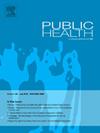通过复杂的卫生干预措施实现卫生公平:采用何种评价方法和设计?范围审查
IF 3.2
3区 医学
Q1 PUBLIC, ENVIRONMENTAL & OCCUPATIONAL HEALTH
引用次数: 0
摘要
健康不平等是一种系统性的、可避免的不平等。虽然许多公共卫生干预措施的目标是减少艾滋病毒感染,但它们的影响并不总是得到评估。我们评估了在何种程度上使用经济指标和方法来评估在复杂的卫生干预措施中减少艾滋病毒感染率。研究设计我们按照Arksey和O'Malley的框架进行了范围审查。方法我们检索PubMed、Scopus、CINAHL、EconLit和PsycINFO,以评估旨在降低HI的公共卫生干预措施。结果490篇筛选文章中,19篇符合纳入标准。大多数研究(n = 10)采用随机对照试验。主要的评价方法是基于社会经济类别的亚组分析(n = 10),其次是相互作用项(n = 5)和差异中的差异(n = 4)。然而,没有研究使用专门的经济指标直接评估HI的减少。结论:尽管降低HI的目标是明确的,但评估往往不能明确地衡量这种影响。这种遗漏带来了方法学上的风险,因为一些干预措施可能无意中扩大了差距。我们提倡系统地纳入经济指标,如基尼指数或方法,如分配成本效益分析,以确保在公共卫生干预措施中更严格地评估HI。本文章由计算机程序翻译,如有差异,请以英文原文为准。
Targeting health equity through complex health interventions: Which evaluation methods and designs are used? A scoping review
Objectives
Health inequalities (HI) are systematic and avoidable disparities. While many public health interventions target HI reduction, their impact is not always evaluated. We assessed the extent to which economic indicators and methods are used to evaluate HI reduction in complex health interventions.
Study design
We performed a scoping review following Arksey and O'Malley's framework.
Methods
We searched PubMed, Scopus, CINAHL, EconLit, and PsycINFO for studies evaluating public health interventions aimed at reducing HI.
Results
Of 490 screened articles, 19 met inclusion criteria. Most studies (n = 10) used randomised controlled trials. The predominant evaluation method was subgroup analyses based on socioeconomic categories (n = 10), followed by interaction terms (n = 5) and difference-in-differences (n = 4). However, no study directly assessed HI reduction using dedicated economic indicators.
Conclusions
Despite the stated goal of reducing HI, evaluations often fail to measure this impact explicitly. This omission poses methodological risks, as some interventions may unintentionally widen disparities. We advocate for systematic inclusion of economic indicators, such as the Gini index or methods, such as Distributional Cost-Effectiveness Analysis, to ensure a more rigorous assessment of HI in public health interventions.
求助全文
通过发布文献求助,成功后即可免费获取论文全文。
去求助
来源期刊

Public Health
医学-公共卫生、环境卫生与职业卫生
CiteScore
7.60
自引率
0.00%
发文量
280
审稿时长
37 days
期刊介绍:
Public Health is an international, multidisciplinary peer-reviewed journal. It publishes original papers, reviews and short reports on all aspects of the science, philosophy, and practice of public health.
 求助内容:
求助内容: 应助结果提醒方式:
应助结果提醒方式:


